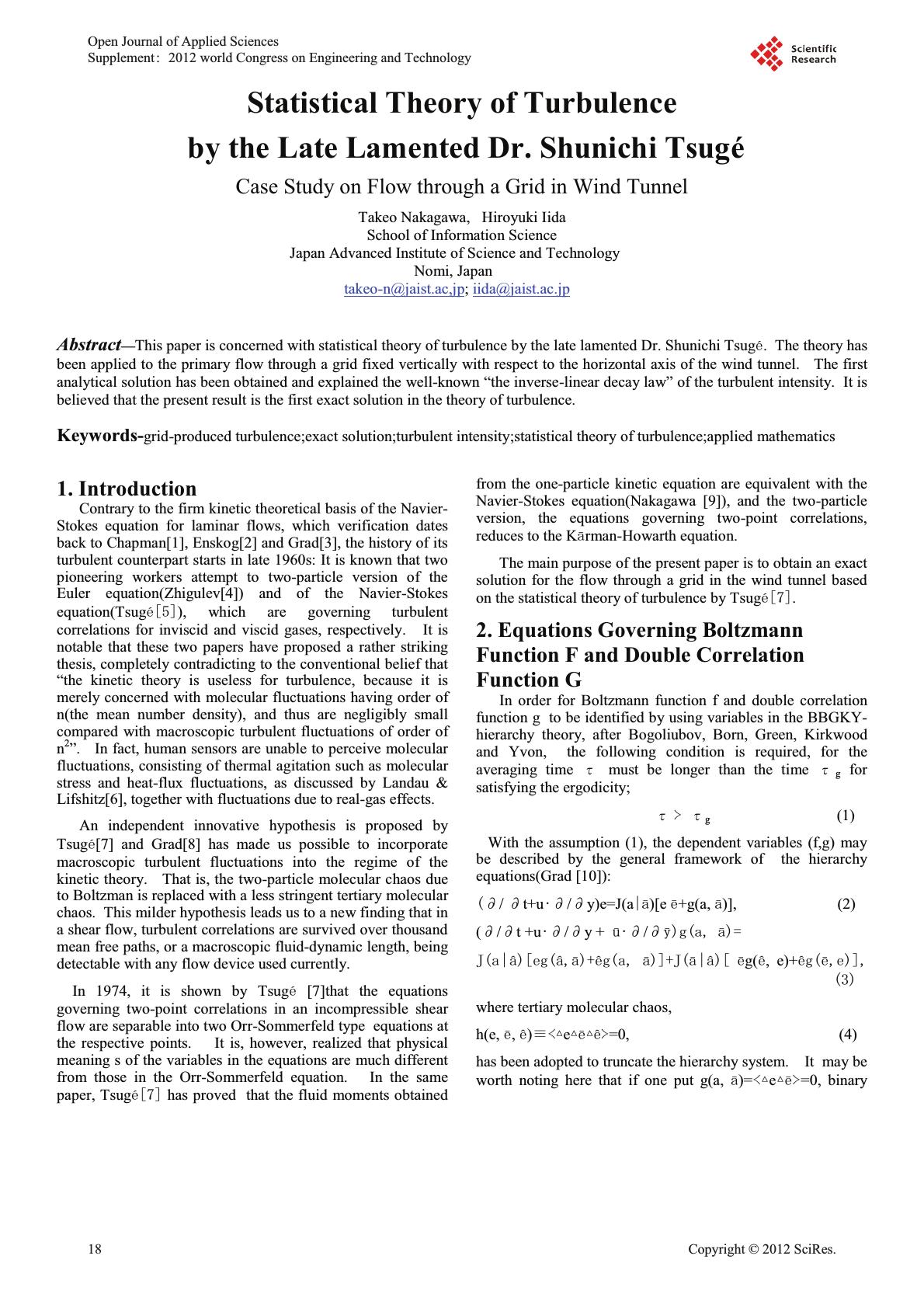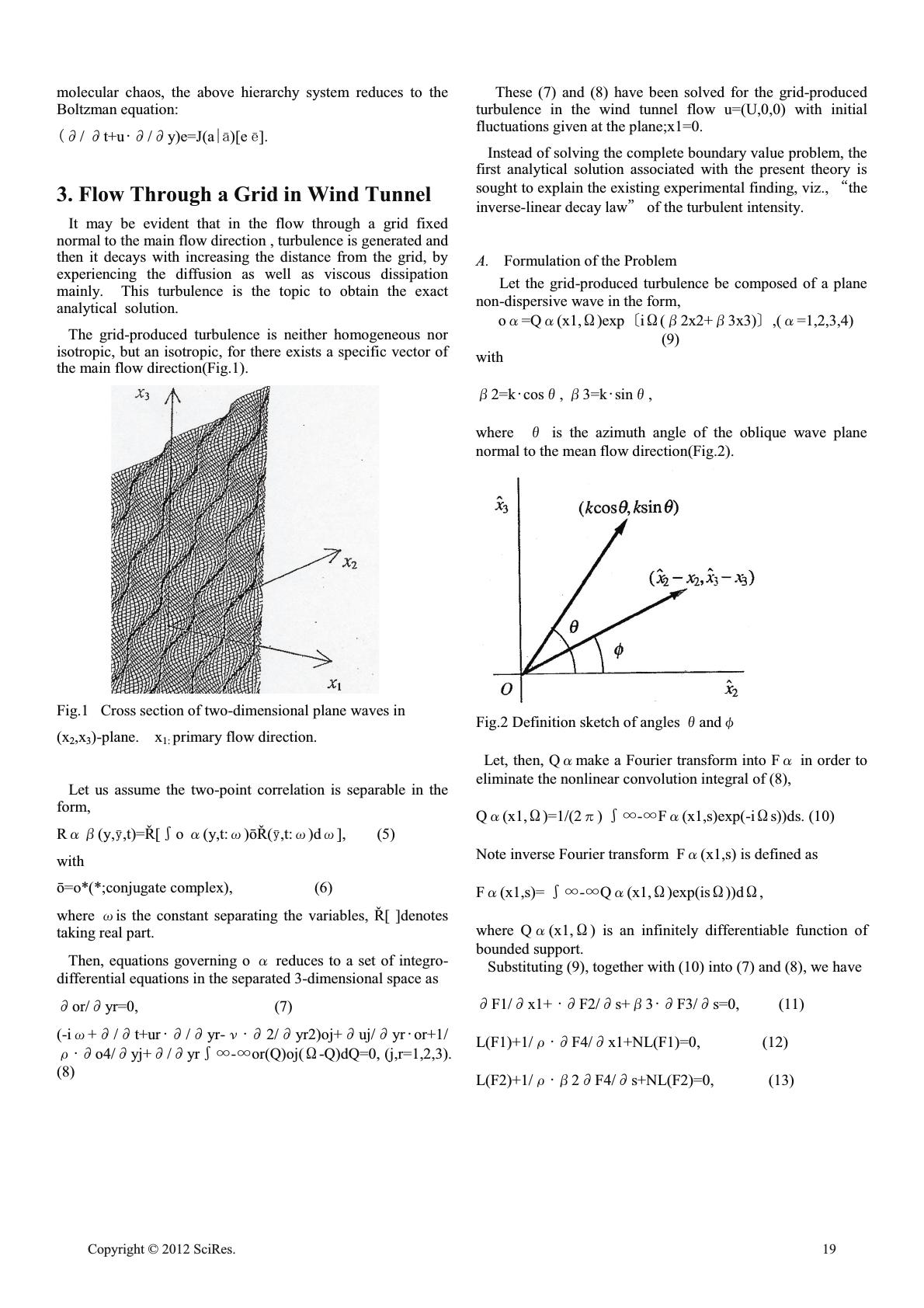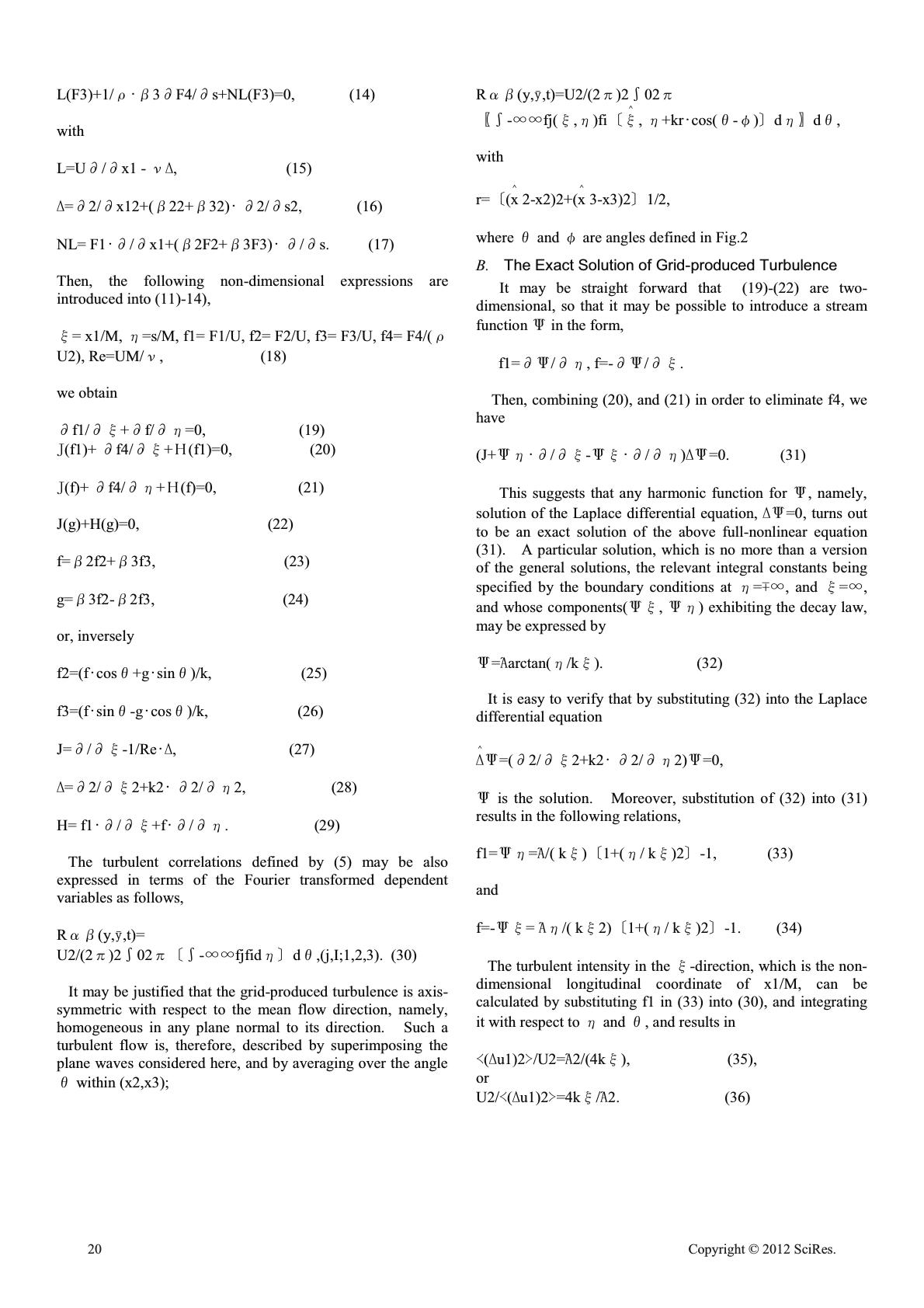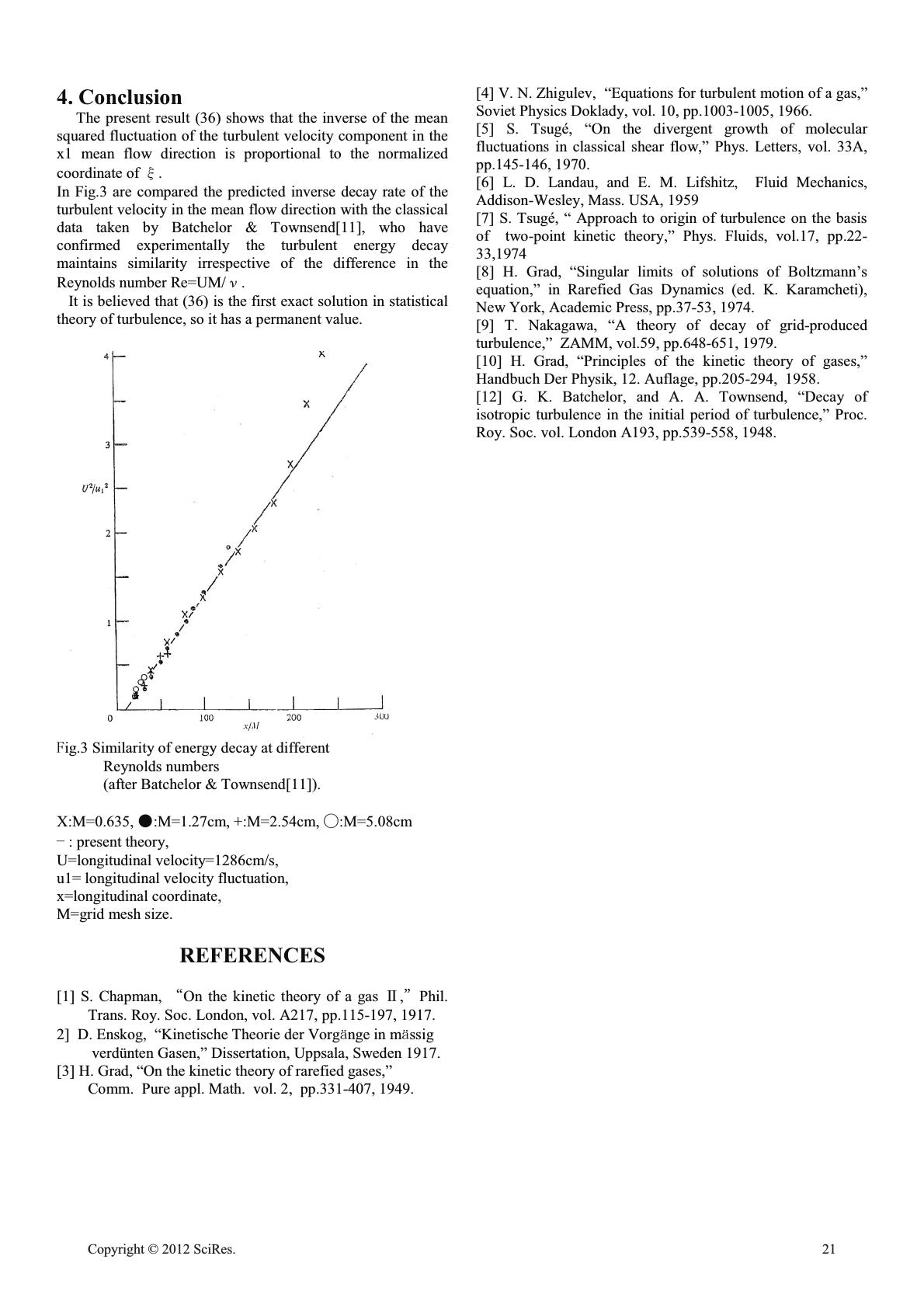Paper Menu >>
Journal Menu >>
 Statistical Theory of Turbulence by the Late Lamented Dr. Shunichi Tsugé Case Study on Flow through a Grid in Wind Tunnel Takeo Nakagawa, Hiroyuki Iida School of Information Science Japan Advanced Institute of Science and Technology Nomi, Japan takeo-n@jaist.ac,jp; iida@jaist.ac.jp Abstract—This paper is concerned with statistical theory of turbulence by the late lamented Dr. Shunichi Tsugª. The theory has been applied to the primary flow through a grid fixed vertically with respect to the horizontal axis of the wind tunnel. The first analytical solution has been obtained and explained the well-known “the inverse-linear decay law” of the turbulent intensity. It is believed that the present result is the first exact solution in the theory of turbulence. Keywords-grid-produced turbulence;exact solution;turbulent intensity;statistical theory of turbulence;applied mathematics 1. Introduction Contrary to the firm kinetic theoretical basis of the Navier- Stokes equation for laminar flows, which verification dates back to Chapman[1], Enskog[2] and Grad[3], the history of its turbulent counterpart starts in late 1960s: It is known that two pioneering workers attempt to two-particle version of the Euler equation(Zhigulev[4]) and of the Navier-Stokes equatio n(T sugª=?), which are governing turbulent correlations for inviscid and viscid gases, respectively. It is notable that these two papers have proposed a rather striking thesis, completely contradicting to the conventional belief that “the kinetic theory is useless for turbulence, because it is merely concerned with molecular fluctuations having order of n(the mean number density), and thus are negligibly small compared with macroscopic turbulent fluctuations of order of n2”. In fact, human sensors are unable to perceive molecular fluctuations, consisting of thermal agitation such as molecular stress and heat-flux fluctuations, as discussed by Landau & Lifshitz[6], together with fluctuations due to real-gas effects. An independent innovative hypothesis is proposed by Tsugª[7] and Grad[8] has made us possible to incorporate macroscopic turbulent fluctuations into the regime of the kinetic theory. That is, the two-particle molecular chaos due to Boltzman is replaced with a less stringent tertiary molecular chaos. This milder hypothesis leads us to a new finding that in a shear flow, turbulent correlations are survived over thousand mean free paths, or a macroscopic fluid-dynamic length, being detectable with any flow device used currently. In 1974, it is shown by Tsugª [7]that the equations governing two-point correlations in an incompressible shear flow are separable into two Orr-Sommerfeld type equations at the respective points. It is, however, realized that physical meaning s of the variables in the equations are much different from those in the Orr-Sommerfeld equation. In the same paper, Tsugª=? has proved that the fluid moments obtained from the one-particle kinetic equation are equivalent with the Navier-Stokes equation(Nakagawa [9]), and the two-particle version, the equations governing two-point correlations, reduces to the KÂrman-Howarth equation. The main purpose of the present paper is to obtain an exact solution for the flow through a grid in the wind tunnel based on the statistical theory of turbulence by Tsugª=?. 2. Equations Governing Boltzmann Function F and Double Correlation Function G In order for Boltzmann function f and double correlation function g to be identified by using variables in the BBGKY- hierarchy theory, after Bogoliubov, Born, Green, Kirkwood and Yvon, the following condition is required, for the averaging time Ǽ must be longer than the time Ǽg for satisfying the ergodicity; Ǽ Ҝ Ǽg (1) With the assumption (1), the dependent variables (f,g) may be described by the general framework of the hierarchy equations(Grad [10]): У/ Уt+uкУ/Уy)e=J(aфÂ)[e Ô+g(a, Â)], (2) (У/Уt +uкУ/Уy + ĬкУ/УˠIC ,Cф£=GI£Â«ICÂ?,Âф£= Ôg( «, e)+«IÔG? where tertiary molecular chaos, h(e, Ô, «)҂қَeَÔَ«Ҝ=0, (4) has been adopted to truncate the hierarchy system. It may be worth noting here that if one put g(a, Â)=қَeَÔҜ=0, binary Open Journal of Applied Sciences Supplement:2012 world Congress on Engineering and Technology 18 Cop y ri g ht © 2012 SciRes.  molecular chaos, the above hierarchy system reduces to the Boltzman equation: У/ Уt+uкУ/Уy)e=J(aфÂ)[e Ô]. 3. Flow Through a Grid in Wind Tunnel It may be evident that in the flow through a grid fixed normal to the main flow direction , turbulence is generated and then it decays with increasing the distance from the grid, by experiencing the diffusion as well as viscous dissipation mainly. This turbulence is the topic to obtain the exact analytical solution. The grid-produced turbulence is neither homogeneous nor isotropic, but an isotropic, for there exists a specific vector of the main flow direction(Fig.1). Fig.1 Cross section of two-dimensional plane waves in (x2,x3)-plane. x1: primary flow direction. Let us assume the two-point correlation is separable in the form, RǩǪ(y,ˠ,t)=ě[ьo ǩ(y,t:ȁ)ǀě(ˠ,t:ȁ)dȁ], (5) with ǀ=o*(*;conjugate complex), (6) where ȁis the constant separating the variables, ě[ ]denotes taking real part. Then, equations governing o ǩ reduces to a set of integro- differential equations in the separated 3-dimensional space as Уor/Уyr=0, (7) (-iȁ+У/Уt+urкУ/Уyr -ǵкУ2/Уyr2)oj+Уuj /Уyrкor+1/ ǹкУo4/Уyj+У/Уyrьп-пor(Q)oj(ǡ-Q)dQ=0, (j,r=1,2,3). (8) These (7) and (8) have been solved for the grid-produced turbulence in the wind tunnel flow u=(U,0,0) with initial fluctuations given at the plane;x1=0. Instead of solving the complete boundary value problem, the first analytical solution associated with the present theory is sought to explain the existing experimental finding, viz., ̌the inverse-linear decay law̍ of the turbulent intensity. A. Formulation of the Problem Let the grid-produced turbulence be composed of a plane non-dispersive wave in the form, oǩ=Qǩ(x1,ǡ)expާiǡ(Ǫ2x2+Ǫ3x3)ި,(ǩ=1,2,3,4) (9) with Ǫ2=kкcosǰ, Ǫ3=kкsinǰ, where ǰ is the azimuth angle of the oblique wave plane normal to the mean flow direction(Fig.2). Fig.2 Definition sketch of angles ǰandǾ Let, then, Qǩmake a Fourier transform into Fǩ in order to eliminate the nonlinear convolution integral of (8), Qǩ(x1,ǡ)=1/(2Ǹ) ьп-пFǩ(x1,s)exp(-iǡs))ds. (10) Note inverse Fourier transform Fǩ(x1,s) is defined as Fǩ(x1,s)= ьп-пQǩ(x1,ǡ)exp(isǡ))dǡ, where Qǩ(x1,ǡ) is an infinitely differentiable function of bounded support. Substituting (9), together with (10) into (7) and (8), we have УF1/Уx1+ кУF2/Уs+Ǫ3кУF3/Уs=0, (11) L(F1 ) + 1 /ǹкУF4/Уx1+NL(F1)=0, (12) L(F2 ) + 1 /ǹкǪ2УF4/Уs+NL(F2)=0, (13) Cop y ri g ht © 2012 SciRes.19  L(F3 ) + 1 /ǹкǪ3УF4/Уs+NL(F3)=0, (14) with L=UУ/Уx1 - ǵЧ, (15) Ч=У2/Уx12+(Ǫ22+Ǫ32)к У2/Уs2, (16) NL= F1кУ/Уx1+( Ǫ2F2+Ǫ3F3)к У/Уs. (17) Then, the following non-dimensional expressions are introduced into (11)-14), Ƕ= x1/M, ǯ=s/M, f1= F1/U, f2= F2/U, f3= F3/U, f4= F4/(ǹ U2), Re=UM/ǵ, (18) we obtain Уf1/УǶ+Уf/Уǯ=0, (19) Ȏ(f1)+ Уf4/УǶ+Ȣ(f1)=0, (20) Ȏ(f)+ Уf4/Уǯ+Ȣ(f)=0, (21) J(g)+H(g)=0, (22) f=Ǫ2f2+Ǫ3f3, (23) g=Ǫ3f2-Ǫ2f3, (24) or, inversely f2=( fкcosǰ+gкsinǰ)/k, (25) f3=( fкsi nǰ-gкcosǰ)/k, (26) J=У/УǶ-1/R eкЧ, (27) Ч=У2/УǶ2+k2к У2/Уǯ2, (28) H= f1кУ/УǶ+fкУ/Уǯ. (29) The turbulent correlations defined by (5) may be also expressed in terms of the Fourier transformed dependent variables as follows, RǩǪ(y,ˠ,t)= U2/(2Ǹ)2ь02Ǹާь-ппfjfi d ǯިdǰ,(j,I;1,2,3). (30) It may be justified that the grid-produced turbulence is axis- symmetric with respect to the mean flow direction, namely, homogeneous in any plane normal to its direction. Such a turbulent flow is, therefore, described by superimposing the plane waves considered here, and by averaging over the angle ǰ within (x2,x3); RǩǪ(y,ˠ,t)=U2/(2Ǹ)2ь02Ǹ ީь-ппfj(Ƕ,ǯ)fiާǶ ^ , ǯ+krкcos(ǰ-Ǿ)ިdǯުdǰ, with r=ާ(x ^ 2-x2)2+(x ^ 3-x3)2ި1/2, where ǰ and Ǿ are angles defined in Fig.2 B. The Exact Solution of Grid-produced Turbulence It may be straight forward that (19)-(22) are two- dimensional, so that it may be possible to introduce a stream function Ǡ in the form, f1=УǠ/Уǯ, f=-УǠ/УǶ. Then, combining (20), and (21) in order to eliminate f4, we have (J+ǠǯкУ/УǶ-ǠǶкУ/Уǯ)ЧǠ=0. (31) This suggests that any harmonic function for Ǡ, namely, solution of the Laplace differential equation, ЧǠ=0, turns out to be an exact solution of the above full-nonlinear equation (31). A particular solution, which is no more than a version of the general solutions, the relevant integral constants being specified by the boundary conditions at ǯ=дп, and Ƕ=п, and whose components(ǠǶ, Ǡǯ) exhibiting the decay law, may be expressed by Ǡ=ǁarctan(ǯ/kǶ). (32) It is easy to verify that by substituting (32) into the Laplace differential equation Ч ^ Ǡ=(У2/УǶ2+k2к У2/Уǯ2)Ǡ=0, Ǡ is the solution. Moreover, substitution of (32) into (31) results in the following relations, f1=Ǡǯ=ǁ/( kǶ)ާ1+(ǯ/ kǶ)2ި-1, (33) and f=-ǠǶ= ǁǯ/( kǶ2)ާ1+(ǯ/ kǶ)2ި-1. (34) The turbulent intensity in the Ƕ-direction, which is the non- dimensional longitudinal coordinate of x1/M, can be calculated by substituting f1 in (33) into (30), and integrating it with respect to ǯ and ǰ, and results in қ(Чu1)2 Ҝ/U2=ǁ2/(4kǶ), (35), or U2/қ(Чu1)2 Ҝ=4 kǶ/ǁ2. (36) 20 Cop y ri g ht © 2012 SciRes.  4. Conclusion The present result (36) shows that the inverse of the mean squared fluctuation of the turbulent velocity component in the x1 mean flow direction is proportional to the normalized coordinate of Ƕ. In Fig.3 are compared the predicted inverse decay rate of the turbulent velocity in the mean flow direction with the classical data taken by Batchelor & Townsend[11], who have confirmed experimentally the turbulent energy decay maintains similarity irrespective of the difference in the Reynolds number Re=UM/ǵ. It is believed that (36) is the first exact solution in statistical theory of turbulence, so it has a permanent value. (ig.3 Similarity of energy decay at different Reynolds numbers (after Batchelor & Townsend[11]). X:M=0.635, ٨:M=1.27cm, +:M=2.54cm, ڈ:M=5.08cm г : present theory, U=longitudinal velocity=1286cm/s, u1= longitudinal velocity fluctuation, x=longitudinal coordinate, M=grid mesh size. REFERENCES [1] S. Chapman, ̌On the kinetic theory of a gas Τ,̍Phil. Trans. Roy. Soc. London, vol. A217, pp.115-197, 1917. 2] D. Enskog, “Kinetische Theorie der Vorgˆnge in mˆssig verdünten Gasen,” Dissertation, Uppsala, Sweden 1917. [3] H. Grad, “On the kinetic theory of rarefied gases,” Comm. Pure appl. Math. vol. 2, pp.331-407, 1949. [4] V. N. Zhigulev, “Equations for turbulent motion of a gas,” Soviet Physics Doklady, vol. 10, pp.1003-1005, 1966. [5] S. Tsugé, “On the divergent growth of molecular fluctuations in classical shear flow,” Phys. Letters, vol. 33A, pp.145-146, 1970. [6] L. D. Landau, and E. M. Lifshitz, Fluid Mechanics, Addison-Wesley, Mass. USA, 1959 [7] S. Tsugé, “ Approach to origin of turbulence on the basis of two-point kinetic theory,” Phys. Fluids, vol.17, pp.22- 33,1974 [8] H. Grad, “Singular limits of solutions of Boltzmann’s equation,” in Rarefied Gas Dynamics (ed. K. Karamcheti), New York, Academic Press, pp.37-53, 1974. [9] T. Nakagawa, “A theory of decay of grid-produced turbulence,” ZAMM, vol.59, pp.648-651, 1979. [10] H. Grad, “Principles of the kinetic theory of gases,” Handbuch Der Physik, 12. Auflage, pp.205-294, 1958. [12] G. K. Batchelor, and A. A. Townsend, “Decay of isotropic turbulence in the initial period of turbulence,” Proc. Roy. Soc. vol. London A193, pp.539-558, 1948. Cop y ri g ht © 2012 SciRes.21 |

